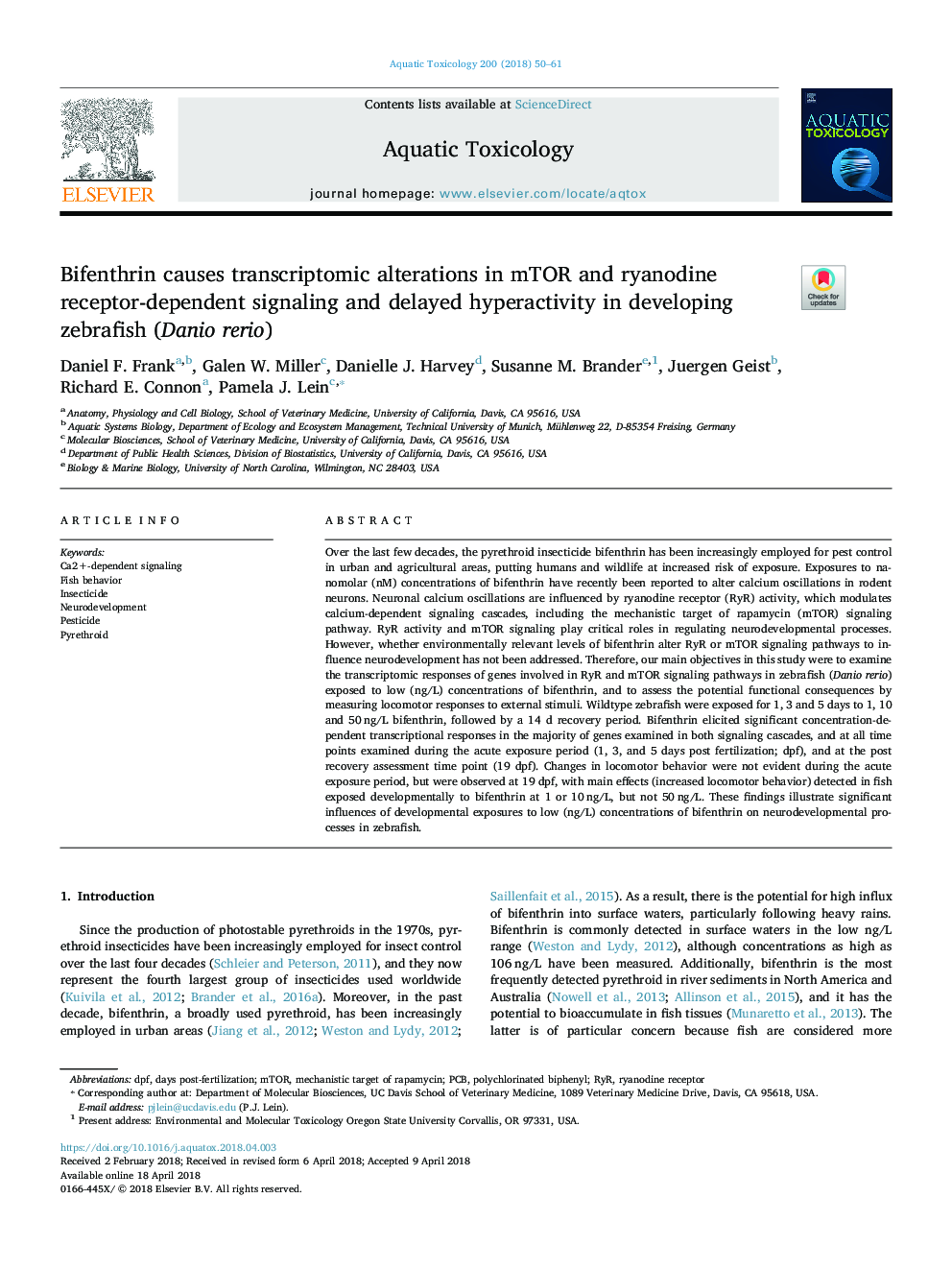| کد مقاله | کد نشریه | سال انتشار | مقاله انگلیسی | نسخه تمام متن |
|---|---|---|---|---|
| 8883693 | 1625905 | 2018 | 12 صفحه PDF | دانلود رایگان |
عنوان انگلیسی مقاله ISI
Bifenthrin causes transcriptomic alterations in mTOR and ryanodine receptor-dependent signaling and delayed hyperactivity in developing zebrafish (Danio rerio)
دانلود مقاله + سفارش ترجمه
دانلود مقاله ISI انگلیسی
رایگان برای ایرانیان
کلمات کلیدی
موضوعات مرتبط
علوم زیستی و بیوفناوری
علوم کشاورزی و بیولوژیک
علوم آبزیان
پیش نمایش صفحه اول مقاله

چکیده انگلیسی
Over the last few decades, the pyrethroid insecticide bifenthrin has been increasingly employed for pest control in urban and agricultural areas, putting humans and wildlife at increased risk of exposure. Exposures to nanomolar (nM) concentrations of bifenthrin have recently been reported to alter calcium oscillations in rodent neurons. Neuronal calcium oscillations are influenced by ryanodine receptor (RyR) activity, which modulates calcium-dependent signaling cascades, including the mechanistic target of rapamycin (mTOR) signaling pathway. RyR activity and mTOR signaling play critical roles in regulating neurodevelopmental processes. However, whether environmentally relevant levels of bifenthrin alter RyR or mTOR signaling pathways to influence neurodevelopment has not been addressed. Therefore, our main objectives in this study were to examine the transcriptomic responses of genes involved in RyR and mTOR signaling pathways in zebrafish (Danio rerio) exposed to low (ng/L) concentrations of bifenthrin, and to assess the potential functional consequences by measuring locomotor responses to external stimuli. Wildtype zebrafish were exposed for 1, 3 and 5 days to 1, 10 and 50â¯ng/L bifenthrin, followed by a 14 d recovery period. Bifenthrin elicited significant concentration-dependent transcriptional responses in the majority of genes examined in both signaling cascades, and at all time points examined during the acute exposure period (1, 3, and 5 days post fertilization; dpf), and at the post recovery assessment time point (19 dpf). Changes in locomotor behavior were not evident during the acute exposure period, but were observed at 19 dpf, with main effects (increased locomotor behavior) detected in fish exposed developmentally to bifenthrin at 1 or 10â¯ng/L, but not 50â¯ng/L. These findings illustrate significant influences of developmental exposures to low (ng/L) concentrations of bifenthrin on neurodevelopmental processes in zebrafish.
ناشر
Database: Elsevier - ScienceDirect (ساینس دایرکت)
Journal: Aquatic Toxicology - Volume 200, July 2018, Pages 50-61
Journal: Aquatic Toxicology - Volume 200, July 2018, Pages 50-61
نویسندگان
Daniel F. Frank, Galen W. Miller, Danielle J. Harvey, Susanne M. Brander, Juergen Geist, Richard E. Connon, Pamela J. Lein,